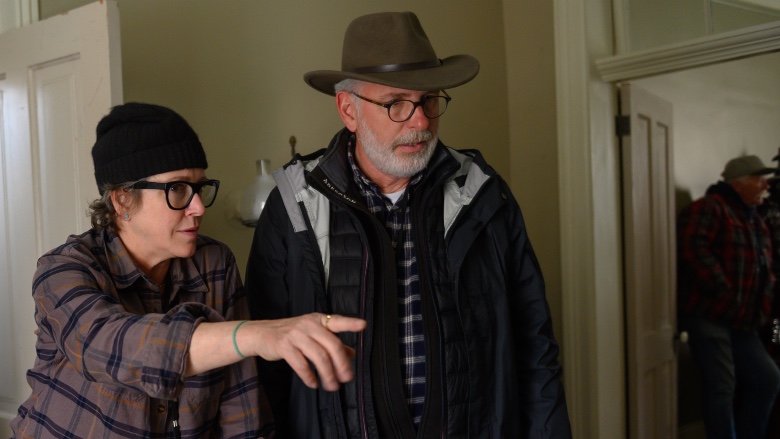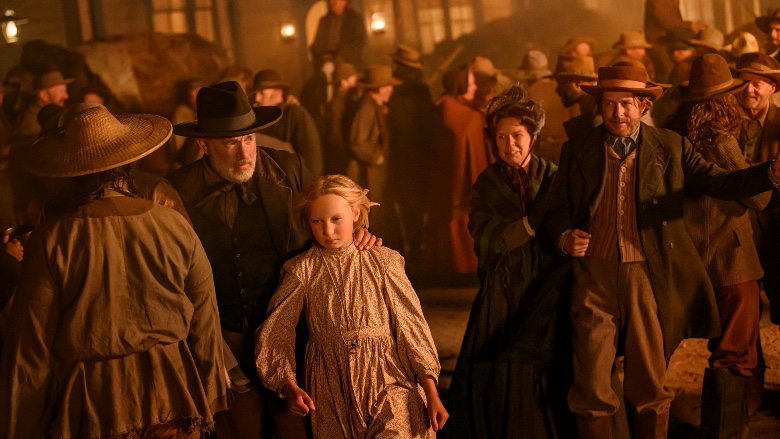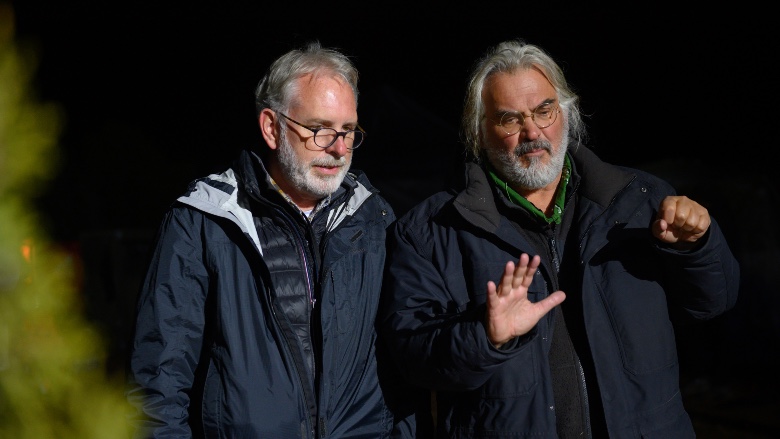
A Civil War veteran and a young orphan journey across Texas in News of the World, a Universal release directed by Paul Greengrass and starring Tom Hanks and Helena Zengel. The movie takes place on a turbulent frontier that ranges from cattle yards to burgeoning towns.
Hanks plays Capt. Jefferson Kidd, a widower who makes a living reading newspaper stories to remote audiences. Working almost entirely with existing locations, Production Designer David Crank and his crew had to fashion the five separate towns that Kidd visits. Each one reflected a different stage in the journey, and each one presented different challenges.
This is Crank’s first collaboration with Greengrass. Previously he had worked with Terrence Malick (The Tree of Life), Steven Spielberg (Lincoln) and Paul Thomas Anderson (There Will Be Blood). His most recent projects include Knives Out and Greyhound.
Crank spoke with Below the Line from his office in Virginia.
Below the Line: Are you a fan of Westerns?
David Crank: I grew up with Westerns, but I never thought about this being a Western. I approached it as a historical story. What interested me was that News of the World was a combination of this huge world and landscape and these two people within it. The overriding thing for me was these two people against this background.
BTL: What were your first steps to recreating 1870s Texas?
Crank: We did a lot of research through historical societies. If you tap into local depositories, you find photographs you’ve never seen before. In Colorado, I found a whole set of glass plate negatives of new towns that actually showed how the frontier grew. When we looked at post-Civil War images, life was very mean and simple and plain. You combine that with trying to find what was being built at the time so you can understand how a town developed.
While talking with Paul in the beginning, we tried very hard to define the purpose of Kidd’s journey. If you’re taking viewers through five towns, each town has to have its own reason, its own story, or it’s just a boring view. So we tried to find the focus of each town, what the point of being there was, and how that reflected in the story. Each one took on a different scale. The first was just a kind of stopping-off place, the second was basically a stockyard for cattle. The third was Dallas, a growing town with influences from all over, then you got to the Castroville area, very insular, and finally San Antonio, which has a Spanish, Southwestern feel.
BTL: The problem with many Westerns is that the towns don’t make sense. You go into the saloon in a dinky little outpost and there are a hundred cowboys inside.
Crank: We not only had a story for each town, we had stories for each spot. We tried to show a progression for the places Kidd does his readings. First, he’s in a storage space. In the second, he’s in the only public space in town, which would have been the church. Dallas was bigger, so we put him in a Mason’s hall. Maybe Kidd had a connection with the Masons, also Masons would lend out their spaces to public groups. The outside reading had a dangerous feel.
Paul wanted to come full circle for the last reading. Kidd’s back in an industrial space, but this one had more light, more life than the first one. Even the general store where Kidd gets his wagon had a story, Paul talked about how it was just barely hanging on, and you see that reflected in its goods.

BTL: How zeroed in do you get with details?
Crank: I was watching a Western the other day, and when Matt Dillon walks out of a front door, there was wicker rug beater hanging next to the door. I was like, “What in the world?” It was just somebody dressing the set and not paying attention. We tried to figure out carefully what each location was so that it was specific to the story.
Paul was very interested in the newspapers Kidd reads. He would come in and go over them very carefully, even the stories that were not in the script. We would do mockups of them, blow them up and put them on a wall. I even hired an illustrator for the small newspaper in Erath.
BTL: How much prep did you have?
Crank: I started at the end of April, and my crews started in the beginning of July. Shooting started in September, so we had almost two months. We scouted a lot of locations. Paul wasn’t there the whole time, but Dariusz [Wolski, Cinematographer] was. Dariusz and I would film little videos of us acting out the script, showing Paul how they would work in locations. The producer’s assistant called us the “Bonanza Creek Players.” I hope those videos never see the light of day.
Our department was a lean machine in a way, quite small. We had a supervising art director, an art director, a graphic designer, and one draftsman. It worked because we weren’t building big towns, we were altering big towns.
BTL: What was the balance of sets you constructed and existing locations?
Crank: I’d say ninety percent of the sets were existing. We built the cemetery, but it was off the back of an old school, so it was something that was there that we altered and added to.
We shot in New Mexico, and everything was in maybe a thirty-mile radius. We used the Bonanza Creek Ranch for three of the five towns, so we had to come up with ways to alter it to fit each town. Plus they were filming chronologically, so we would prepare for when Kidd arrived in Wichita Falls. After those scenes we had I think five days to re-dress everything for the next town. All of the interiors were altered from what was there. A lot of the rooms were wacky, because other movies had shot in them and altered them in very strange ways. It’s like, “Someone probably did this because of that.” And then you add onto it or simplify it. The big thing is to make it less confusing. You want to be able to see a scene and immediately understand what it’s about.

BTL: How do you make it less confusing?
Crank: You edit out superfluous things that grab the eye but aren’t necessary to a scene. We went through the towns and got rid of all the contrasting trim, brought them into one color palette, because otherwise you might look and see a hundred windows. The windows aren’t important, so I don’t want you to see them. For somebody else’s story that might be what you want, but not for this one.
With Paul’s background in documentaries, he’s very interested in what’s real. That’s what I thought from the beginning: If it isn’t real, he isn’t going to shoot it.
BTL: How did you collaborate with Greengrass?
Crank: This was my first time working with him. He’s an utter gentleman, very easy to talk to. I set up a thing with him in the beginning where I would come to his trailer for the last ten minutes of lunch with one or two questions. That way we got potential problems out of the way, so he was never surprised when he got to the set.
I think he likes to come onto the set and discover the day’s shooting. He doesn’t want to know everything — he wants to react. He also expected you to do your job and come up with something for him to react to.
BTL: He didn’t want to go over the sets beforehand?
Crank: It’s not like he didn’t want to know, but that he didn’t want to get involved with, say, the color of the paint, this, that, and the other. That was my job. The day of, we’d clear set, he’d come in and walk around, looking at things. I’d say this is the way I saw the scene happening. He’d either agree and build from that or he might want something changed. He was excited to see what you brought that he wasn’t expecting, because, as I said, he likes to react.
BTL: It seems that locations shifted a great deal during production.
Crank: We stuck to our schedule. We knew the overall scope of the production — that didn’t change — but all of the details — we moved interiors from one place to another, for example.
You can make a decision about something in July, like, “We’re going to do scene 30 this way.” And then when we’re shooting and you’ve done scene 1 through 25, suddenly scene 30 doesn’t mean the same thing anymore. Something’s evolved, and what you’ve decided two months ago is probably not right anymore.
With There Will be Blood, we had planned the house for Daniel’s character [oil tycoon Daniel Plainview, played by Daniel Day-Lewis] at the end of the movie, based on what we had scouted several months before. By the time we got there, his character had taken a different turn, so we had to make these quick changes.
But it was all for the better. You never mind doing it when it’s for the better. Somebody else asked me what I had learned on this production. I think it’s that you become more comfortable when they ask you to change something. You say, “Sure.”
News of the World is still in some movie theaters across the country, and it’s also available On Demand.
All photos courtesy of Universal Pictures.





